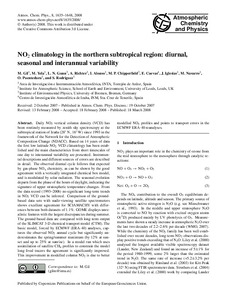Por favor, use este identificador para citar o enlazar este ítem:
http://hdl.handle.net/20.500.11765/392
NO2 climatology in the northern subtropical region: diurnal, seasonal and interannual variability
| Título : | NO2 climatology in the northern subtropical region: diurnal, seasonal and interannual variability |
| Autor : | Gil-Ojeda, Manuel; Yela González, Margarita; Gunn, Lara N.; Richter, Andreas; Alonso, I.; Chipperfield, Martyn P.; Cuevas Agulló, Emilio





|
| Palabras clave : | Vertical column density; NO2 variability; Spectroscopy; Dióxido de nitrógeno; Espectrómetros |
| Fecha de publicación : | 2008 |
| Editor: | European Geosciences Union |
| Citación : | Atmospheric Chemistry and Physics. 2008, 8(6), p. 1635-1648 |
| Versión del editor: | https://dx.doi.org/10.5194/acp-8-1635-2008 |
| Resumen : | Daily NO2 vertical column density (VCD) has been routinely measured by zenith sky spectroscopy at the subtropical station of Izaña (28° N, 16° W) since 1993 in the framework of the Network for the Detection of Atmospheric Composition Change (NDACC). Based on 14 years of data the first low latitude NO2 VCD climatology has been established and the main characteristics from short timescales of one day to interannual variability are presented. Instrumental descriptions and different sources of errors are described in detail. The observed diurnal cycle follows that expected by gas-phase NOx chemistry, as can be shown by the good agreement with a vertically integrated chemical box model, and is modulated by solar radiation. The seasonal evolution departs from the phase of the hours of daylight, indicating the signature of upper stratospheric temperature changes. From the data record (1993–2006) no significant long-term trends in NO2 VCD can be inferred. Comparison of the ground-based data sets with nadir-viewing satellite spectrometers shows excellent agreement for SCIAMACHY with differences between both datasets of 1.1%. GOME displays unrealistic features with the largest discrepancies during summer. The ground-based data are compared with long-term output of the SLIMCAT 3-D chemical transport model (CTM). The basic model, forced by ECMWF (ERA-40) analyses, captures the observed NO2 annual cycle but significantly underestimates the spring/summer maximum (by 12% at sunset and up to 25% at sunrise). In a model run which uses assimilation of satellite CH4 profiles to constrain the model long-lived tracers the agreement is significantly improved. This improvement in modelled column NO2 is due to better modelled NOy profiles and points to transport errors in the ECMWF ERA-40 reanalyses. |
| Patrocinador: | Routine measurements have been possible thanks to the funding provided by the projects QUILT (EU EVK2-CT2000-0059) SCOUT-O3 (EU 505390-GOCE-CT-2004), TROMPETA (MCyT CGL2004-03669) and is on-going through GEOMON (EU FP6-2005-Global-4- 036677). |
| URI : | http://hdl.handle.net/20.500.11765/392 |
| ISSN : | 1680-7316 1680-7324 |
| Colecciones: | Artículos científicos 2005-2009 |
Ficheros en este ítem:
| Fichero | Descripción | Tamaño | Formato | ||
|---|---|---|---|---|---|
| acp-8-1635-2008.pdf | 1,1 MB | Adobe PDF |  Visualizar/Abrir |
Los ítems de Arcimis están protegidos por una Licencia Creative Commons, salvo que se indique lo contrario.





